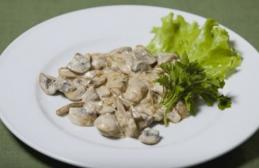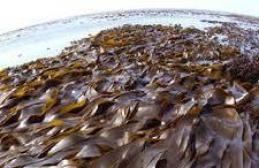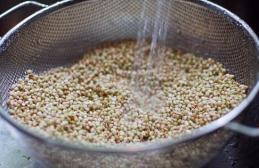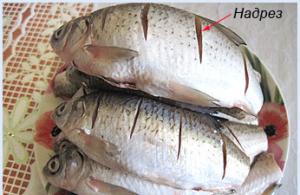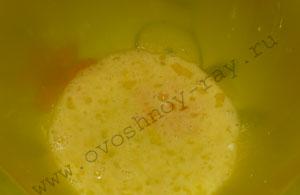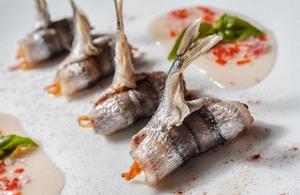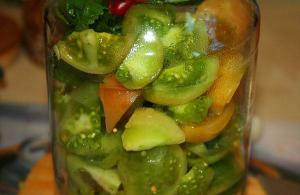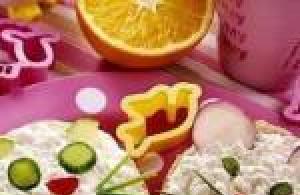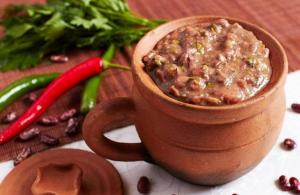|
Product Name |
Weight, g |
Chemical composition |
|
|||
|
gross |
net | |||||
|
Rice groats | ||||||
|
Bulb onions | ||||||
|
Vegetable oil | ||||||
Yield: 250.
For diets No. 5, 7, 10, 15.
Cooking technology. The meat is cut into cubes. Then the meat is fried until a soft golden brown crust forms. Sort the rice, wash, soak for 1.5-2 hours in salted water at room temperature. Cut the onion into strips, scald and lightly sauté with carrots in vegetable oil (simmer for diet No. 5). Pour hot water over the vegetables, equal in weight to the soaked rice, bring to a boil, add rice, cook over low heat until thickened.
The pilaf is evaporated in a water bath on the edge of the stove with the lid closed or in a steam oven.
When releasing, the pilaf is loosened, placed in a heap on a plate, and sprinkled with herbs.
Supply temperature - 65 0 C.
Quality requirements. The consistency is crumbly, vegetables and meat are evenly distributed. Cereals and vegetables are soft. The color is white with a faint orange tint. Foreign odors and tastes are not allowed.
TECHNOLOGICAL CARD No. 265Name of dish:Pancakes with butter, jam, jam, honey
|
Product Name |
Weight, g |
Chemical composition |
Energypriceness, kcal |
|||
|
gross |
net | |||||
|
Wheat flour | ||||||
|
Milk or water | ||||||
|
Butter | ||||||
|
Dough weight | ||||||
|
Vegetable oil | ||||||
|
Lots of fried pancakes | ||||||
|
Butter | ||||||
|
or jam, we're lying | ||||||
|
TOTAL | ||||||
Yield: with oil 160;
with jam, jam 165; with honey 165.
For diets No. 2, 7, 10, 15.
Cooking technology. Stir eggs, sugar, salt, add cold milk or water (1/2 the norm), add flour and beat until smooth, gradually adding the remaining milk or water. The finished batter (humidity 66%) is filtered. Pancakes are baked in greased and heated frying pans with a diameter of 240-260 mm on both sides.
Dispensed with butter, jam, jam or honey, 3 pcs. per serving.
Supply temperature - not lower than 65 0 C.
Quality requirements. The pancakes are the same size and thickness, well baked, without cracks or bubbles. The color ranges from yellow to light brown, the consistency is soft and elastic.
ROUTING№ 38 Blue name:Potato soup with pasta
|
Product Name |
Weight, g |
Chemical composition |
Energy value, kcal |
|||
|
gross |
net | |||||
|
Pasta | ||||||
|
Potato | ||||||
|
Bulb onions | ||||||
|
Butter | ||||||
Yield: 200.
For diets No. 1,2,5,7, 10, 15 (7, 10-6 without salt).
Cooking technology. Place potatoes, carrots, parsley, and blanched onions poached with butter in boiling water and cook for 10-15 minutes, then add pasta and cook for another 15 minutes. The pasta is added before the vegetables, the noodles at the same time as the potatoes, and the noodles 10-15 minutes before the soup is ready.
You can blanch the pasta or boil it until half cooked separately, then the broth will be clearer.
Supply temperature - 65 0 C.
Quality requirements. Pasta, roots, and onions retained their shape. The taste and aroma of the roots and broth from which the soup is made, without the sour aftertaste. The broth is transparent, slight cloudiness is allowed. The color of chicken and meat broth is amber, yellow. The consistency of the roots and pasta is soft.
Technical and technological map No.Pilaf with pork(Wed-10.30)
Publishing house "Gamma Press", Moscow 2003
- APPLICATION AREA
This technical and technological map applies to pilaf with pork, generated into the name of the object, city.
- REQUIREMENTS FOR RAW MATERIALS
Food raw materials, food products and semi-finished products used for cooking pilaf with pork, must comply with the requirements of current regulatory and technical documents, have accompanying documents confirming their safety and quality (certificate of conformity, declaration of conformity, quality certificate, etc.).
The preparation of raw materials is carried out in accordance with the recommendations of the Collection of technological standards for public catering establishments and technological recommendations for imported raw materials.
- RECIPE
| Name | Raw material consumption per serving, g | ||||
| Gross weight, g | % cold processed | Net weight, g | % during heat treatment | Output, g | |
| Pork pulp (stripping act) | 480,0 | 0,00 | 480,0 | 32,00 | 326,0 |
| Steamed rice | 410,0 | 0,00 | 410,0 | Weld 280% | 1148,0 |
| Peeled carrots, semi-finished | 150,0 | 0,00 | 150,0 | 32,00 | 102,0 |
| Onion, semi-finished | 150,0 | 0,00 | 150,0 | 26,00 | 111,0 |
| Vegetable oil | 180,0 | 0,00 | 180,0 | 37,00 | 113,0 |
| Seasoning for pilaf | 6,0 | 0,00 | 6,0 | 100,00 | 0,0 |
| Salt | 20,0 | 0,00 | 20,0 | 100,00 | 0,0 |
| Water | 820,0 | 0,00 | 820,0 | 100,00 | 0,0 |
| Parsley greens, p/f | 10,0 | 0,00 | 10,0 | 100.00 (decor) | 0,0 |
| Exit | 12x150 -1800 g | ||||
- Cooking technology Pilaf with pork
Cut the pork flesh into pieces in the form of cubes 2-3 cm in size - medium-sized (weight of the pieces - 20-30 g). Onions are cut into strips, carrots into 4x4 mm strips, 4 cm long.
Heat vegetable oil in a thick-walled frying pan, lay out the pork and fry it lightly, without frying too much, otherwise all the meat juices will remain inside and the pilaf will be less saturated with meat aroma. Then add chopped vegetables (onions, carrots) and fry until golden brown with constant stirring. Season with salt and seasoning for pilaf. Pour water into the frying pan so that it completely covers the vegetables and meat, reduce the heat, simmer the meat and vegetables for about 20-30 minutes, depending on the hardness of the meat.
Add pre-washed steamed rice. Add hot water. The liquid should cover the rice by about 2 cm. Check the mixture for salt. It should be over-salted by 15-20%. Cover the frying pan with a lid, leave the pilaf to simmer over low heat (stove or frying pan heat regulator “1”) for 25-30 minutes. The finished pilaf is stirred from the edges of the pan to the center, left under the lid for another 15-20 minutes, then portioned.
In the finished pilaf, the rice grains should be separated from each other. The liquid should evaporate almost completely.
- Characteristics of the finished dish Pilaf with pork
Appearance - fluffy long-grain yellowish rice mixed with fried stewed vegetables and pork.
Taste– characteristic of pilaf ingredients. No foreign taste.
Smell– characteristic of pilaf ingredients. No foreign smell.
- Requirements for registration, sale and storage of Pilaf with pork
Name of dish:Tea with sugar, jam, chalk
|
Product Name |
Weight, g |
Chemical composition |
Energy value, kcal |
|||
|
gross |
net | |||||
|
Tea (infusion) | ||||||
|
or jam | ||||||
Yield: 200.
For diets No. 1, 2, 5, 10, 15.
Cooking technology. Pour 50 g of strained tea leaves into glasses and add boiling water.
When dispensing, sugar, jam, and honey are added to each serving.
Serving temperature - 65 "C.
In summer, tea can be sold as a soft drink. The supply temperature in this case is 14 "C.
Quality requirements. The aroma and taste of the drink are characteristic of the tea variety. Depending on the additive, the tea takes on the taste of honey or jam. The drink is transparent, brown in color. If the tea is opaque or dull brown in color, it is not brewed correctly.
TECHNOLOGICAL CARD No. 34Name of dish: Siberian borscht
|
Product Name |
Weight, g |
Himi |
ngkii composition |
Energypriceness, kcal |
||
|
gross |
net | |||||
|
Potato | ||||||
|
Bulb onions | ||||||
|
Butter | ||||||
|
Tomato puree | ||||||
|
or citric acid | ||||||
For diets No. 2.5,7.8,9. 10, 15 (7, 10 - without salt).
Cooking technology. The beets are boiled whole in their skins, cooled, and chopped into strips. The potatoes are peeled and cut into cubes. The carrots are chopped into thin strips, the onions into half rings. Carrots and onions are sauteed at a temperature of 110 0 C, then simmered with the addition of broth. Place sautéed carrots and onions into the boiling broth and cook for 10 minutes. Then add beets, sautéed tomato puree or a solution of citric acid to preserve the color of the beets and soup, and cook until tender. 5 minutes before readiness add salt, sugar and bay leaf.
For diet No. 5, the onions are blanched and citric acid is not used.
Add sour cream and finely chopped herbs to the finished beetroot soup, bring to boiling.
Supply temperature - 65 0 C.
Requirements To quality. On the surface of the beetroot there are sparkles of fat and finely chopped greens. The vegetables retained their cut shape. The color of the liquid part ranges from bright to dark crimson. The taste is sweetish. The smell of stewed roots and onions. The smell of raw beets and steamed vegetables is not allowed. The consistency of the beets is slightly crunchy.
TECHNOLOGICAL CARD No. 161Name of dish: ShNickel "School"
|
Product Name |
Weight, g |
Chemical composition |
Energypriceness, kcal |
|||
|
gross |
net | |||||
|
Wheat bread | ||||||
|
Weight of semi-finished product | ||||||
|
Oil grows |E(HS/TL) | ||||||
|
Weight of finished products | ||||||
|
or butter | ||||||
Yield: with sauce 100; with oil 75.
For diets No. 2, 15.
Cooking technology. The peeled meat is ground in a meat grinder, combined with stale wheat bread without crusts, soaked in milk or water, salt is added and passed through the meat grinder a second time. The mass is mixed, cutlets are formed into oval-flattened shapes 1.5-2 cm thick, meatballs are round, flattened shapes 2-2.5 cm thick. Schnitzels are flat-oval shapes 1 cm thick.
The products are breaded in breadcrumbs or white breadcrumbs and fried in a hot frying pan with fat heated to a temperature of 150-160°C for 3-5 minutes on both sides until a light crust forms. Then cooked in an oven at a temperature of 250-280°C. for 5 7 min. Readiness is determined by the appearance of air bubbles on the surface of the product, then checked on the cut.
Serve with a side dish and pour over sauce or melted butter.
Supply temperature - 65 "WITH.
Quality requirements. The products have the correct shape, are breaded with a thin layer. The surface is without cracks, covered with a golden brown crust. The taste is moderately salty. The consistency is lush and juicy. The smell of meat. When cut, there is a homogeneous mass, without individual pieces of meat, bread, or tendons. Pinkish-red tint is not allowed.
TECHNOLOGICAL CARD No. 88Name of dish:Milk semolina porridge viscous
|
Product Name |
Weight, g |
Chemical composition |
Energycheskaya pricesness, kcal |
|||
|
gross |
net | |||||
|
Semolina | ||||||
|
Mass of porridge | ||||||
|
Butter | ||||||
Output: 150\5.
For diets No. 1,2, 5, 7,10,15 (7.10 - without salt).
Cooking technology. Semolina is quickly poured in a thin stream into boiling water mixture and milk, salt and sugar with active stirring from top to bottom and cook for 20 minutes with continuous stirring.
When leaving, season with melted butter.
Supply temperature - 65 0 C.
Quality requirements. The porridge on the plate lies in a heap, homogeneous, the grains of the cereal are completely swollen. White color. Foreign tastes and odors, including burnt milk and porridge, are not allowed.
“Preparing salads” - Organization of the workplace. The sequence of the technological process for preparing salads. Varieties of salads. "Slide" design. Salads - cocktails. Various salad design options. Scheme for preparing Stolichny salad. Modern design style. Scheme for preparing vegetable vinaigrette.
“Cold dishes and snacks” - Sandwiches. Cocktail salads. Rolls. Banquet small cold appetizers. Sandwiches and their classification. Cold dishes and snacks. Cooking technology. Sandwiches. Snacks on matches. Dishes for serving cold dishes and snacks. Meat dishes and snacks. Hot appetizers. Fish dishes and snacks. Salads.
“Side dishes for meat” - You can also bake potatoes directly on the main dish. That's it, the tasty and aromatic dish is ready! Then pour the rice in there and pour boiling water over it. Cut the potatoes in half lengthwise and boil in boiling water for 10 minutes. Mashed potatoes with baked garlic. Serve hot as a side dish. Rice with vermicelli (ruz maa shaariye).
“Sandwiches” - Design of sandwiches. Sandwiches are closed. Products. Canapes. Hamburgers. Fish and fish products. Shelf life of sandwiches. Methods for slicing bread. Multilayer sandwich. Cheeseburgers. Sandwiches are open. Necessary products. Tools. Cheeses. Making sandwiches. Oil and oil mixtures. Dishes.
“Egg Spoilage” - Egg defects. Egg components. Krasyuk. Blood stain. Small and large spots. Microbial spoilage of eggs. Rotting. Bacterial cuff. Exogenous contamination. An egg removed from the incubator. Tech. Drying. Insemination of eggs. Endogenous seeding. Microflora.
"Eggs" - Modern Science. Use only fresh, well-washed eggs. Eggs are used to make scrambled eggs and omelettes. Egg experts. Cook Kalorievich. The structure of the egg. Egg in art. Museum "Pysanka". A world of sunshine in a shell. Always use a small saucepan. Laboratory work. Eggs are preserved better if they lie with the blunt end up.
There are 31 presentations in total

